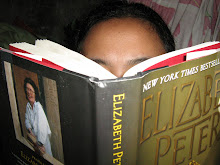It's been a while since I last posted -- yeah yeah I know, understatement much. I hope to have more time to blog now that I'm supposed to be on vacation. [What's rest, mama?] And more time to notice more interesting things to talk about and actually sit down and analyze them.
Anyway, since it's Valentine's Day, I figured it would be fitting to do this post.
You see,. I'm back at home, so I'm pestering my old aunt to tell me more family stories. For the first time, she told me how my great-grandfather won a princess for his bride. I've always known that one of my ancestresses was a binukot, but I didn't know who exactly.
According to my aunt, my grandmother --her and dad's mother -- was beautiful when she was young. Her father-- my great-grandfather, Tatay Mal-am-- was an encargado on a large estate in Iloilo, and had only two children, my grandmother and her brother. Before he was an encargado, however, he was a revolutionary, and he and his fellow members of the local Katipunan [where my grandfather's father's distant cousin, Teresa Magbanua, later rose to prominence] met and camped somewhere in the middle of Panay, where there were Sulodnon people, the so-called tumandok, the indigenous people of the island. The Sulodnon still carried on the practice of binukot-- the most beautiful women in the tribe were shut away from the eyes of the world, and they were never allowed to set foot on the ground. But Tatay Mal-am, so my aunt said, somehow made up his mind to win one of these princesses for his bride... so he went to the house of the woman's father and thrust his bolo into the foot of the stairs leading up to the house, announcing his intention to court her. He and his men often brought gifts-- meat of the wild boars they had caught, among others. Anyway, he finally got the father's permission to marry the girl he wanted.
The problem was that the village required the marriage ceremonies to be long and elaborate... he was going to marry one of their princesses after all. Tatay Mal-am, my aunt said, got fed up with all the hoopla and stole his bride away to the lowland, where he married her in a church. She was my great-grandmother, Nanay Mal-am. After the Revolution, he became encargado on an estate, and raised my grandmother and her brother in luxury. Aunt says that when grandmother was younger, and even after she married grandfather and had children, she liked to wear silk dresses and silk stockings -- in many different colors, each wrapped in tissue to prevent snags and runs -- and pretty shoes. Guess I know where I got that streak, huh?
Anyway, Tatay Mal-am wanted his precious daughter to marry someone he liked, and when he set eyes on my grandfather --who was fifteen years older than grandma-- he wanted him to be his son-in-law. Grandfather was then just a visitor to their town-- he ended up marrying grandma and moving in with them, since Tatay Mal-am wanted his daughter to go on living in luxury. Their oldest child-- my oldest uncle, the one we tracked down on Friendster after he left home over 30 years ago-- was born in the encargado's house, and my aunts spent their early childhood there. It was only after World War II-- a time when villages were warned by tambulis [carabao horns] that the Japanese were coming, and the people hid in bamboo thickets and cornfields until they had passed, for if the Japanese found anyone they would kill them-- that Grandfather brought his family back to his own hometown, and there my father, his youngest child, was born.

Anyway, since it's Valentine's Day, I figured it would be fitting to do this post.
You see,. I'm back at home, so I'm pestering my old aunt to tell me more family stories. For the first time, she told me how my great-grandfather won a princess for his bride. I've always known that one of my ancestresses was a binukot, but I didn't know who exactly.
According to my aunt, my grandmother --her and dad's mother -- was beautiful when she was young. Her father-- my great-grandfather, Tatay Mal-am-- was an encargado on a large estate in Iloilo, and had only two children, my grandmother and her brother. Before he was an encargado, however, he was a revolutionary, and he and his fellow members of the local Katipunan [where my grandfather's father's distant cousin, Teresa Magbanua, later rose to prominence] met and camped somewhere in the middle of Panay, where there were Sulodnon people, the so-called tumandok, the indigenous people of the island. The Sulodnon still carried on the practice of binukot-- the most beautiful women in the tribe were shut away from the eyes of the world, and they were never allowed to set foot on the ground. But Tatay Mal-am, so my aunt said, somehow made up his mind to win one of these princesses for his bride... so he went to the house of the woman's father and thrust his bolo into the foot of the stairs leading up to the house, announcing his intention to court her. He and his men often brought gifts-- meat of the wild boars they had caught, among others. Anyway, he finally got the father's permission to marry the girl he wanted.
The problem was that the village required the marriage ceremonies to be long and elaborate... he was going to marry one of their princesses after all. Tatay Mal-am, my aunt said, got fed up with all the hoopla and stole his bride away to the lowland, where he married her in a church. She was my great-grandmother, Nanay Mal-am. After the Revolution, he became encargado on an estate, and raised my grandmother and her brother in luxury. Aunt says that when grandmother was younger, and even after she married grandfather and had children, she liked to wear silk dresses and silk stockings -- in many different colors, each wrapped in tissue to prevent snags and runs -- and pretty shoes. Guess I know where I got that streak, huh?
Anyway, Tatay Mal-am wanted his precious daughter to marry someone he liked, and when he set eyes on my grandfather --who was fifteen years older than grandma-- he wanted him to be his son-in-law. Grandfather was then just a visitor to their town-- he ended up marrying grandma and moving in with them, since Tatay Mal-am wanted his daughter to go on living in luxury. Their oldest child-- my oldest uncle, the one we tracked down on Friendster after he left home over 30 years ago-- was born in the encargado's house, and my aunts spent their early childhood there. It was only after World War II-- a time when villages were warned by tambulis [carabao horns] that the Japanese were coming, and the people hid in bamboo thickets and cornfields until they had passed, for if the Japanese found anyone they would kill them-- that Grandfather brought his family back to his own hometown, and there my father, his youngest child, was born.

This entry was posted
at Tuesday, February 14, 2012
and is filed under
personal,
Philippine culture,
philippine history
. You can follow any responses to this entry through the
comments feed
.











